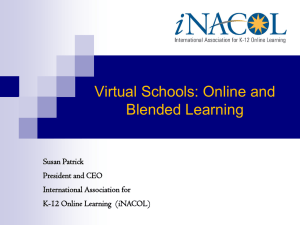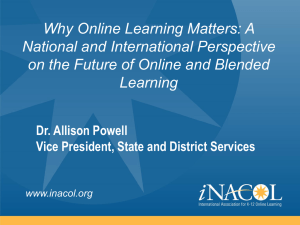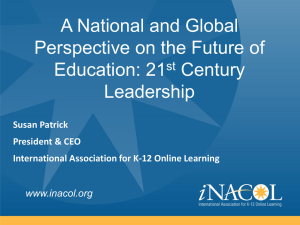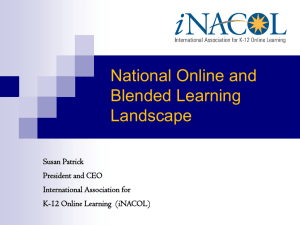Allison Powell Keynote - NextGe TeacherPrep
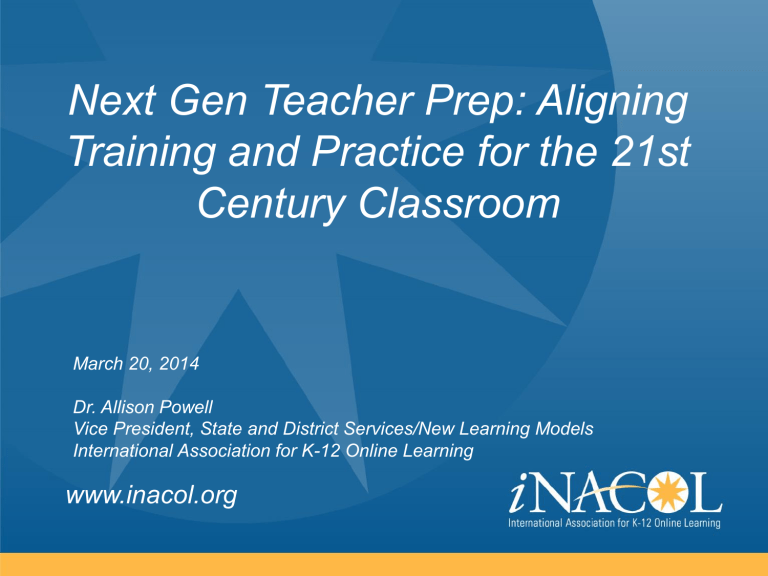
Next Gen Teacher Prep: Aligning
Training and Practice for the 21st
Century Classroom
March 20, 2014
Dr. Allison Powell
Vice President, State and District Services/New Learning Models
International Association for K-12 Online Learning www.inacol.org
iNACOL
• i NACOL is the premier K-12 nonprofit in blended, online, and competency-based learning
• Provides leadership, advocacy, research, training, and networking with experts in K-12 online learning.
– 4700+ members in K-12 online and blended learning in over
50 countries
– Annual conference – iNACOL Blended and Online Learning
Symposium – Palm Springs, CA on November 4-7, 2014
• “ Ensure every student has access a world class education ” regardless of geography, income or background.
• Our strategic areas of focus in online and blended learning:
1. Policy
2. Quality
3. New Learning Models
Blended
Schools
Philanthropy/
Foundations
3,361
Teachers &
Educators
Charter
Schools
Think
Tanks
International
Programs
Parents
Policy
Makers
State
Virtual
Schools
Colleges &
Universities
Non-profit/
Associate
OER
Full-time
Online
Schools
Public
School
Districts
TA Providers
Next
Generation
Learning
Partners
Regional
Education
Agencies
Part-time
Online
Programs
Researchers
& Evaluators
State
Departments of Education www.inacol.org
iNACOL Partners & Members
CMOs/
EMOs
Online Content
Providers
Tech Tools
Providers
Private &
Independent
Schools
Tutoring/S ervices
GPS
Time to Destination
Does every student have access to a world-class education?
New Solutions through Online Learning
• 40% of US high schools do not offer AP courses
– 75% of districts use online learning to offer Advanced
Placement or college-level courses.
• Teacher Shortages
– 40% of public school districts in America today say they need online learning resources because certified teachers are not available for traditional face-to-face instruction.
• More than 50% need online learning to reduce student scheduling conflicts to graduate on time.
• 60% of school districts say they need online learning for credit recovery.
Providing Opportunities to All Students
Traditional
Public/Private
Accelerated
Students
Credit Recovery
Medically Fragile
Need to work and/or support family
Home Schoolers
Special Education and
ELL
Aspiring athletes and performers
Rural Students
U.S. Online Learning Facts
• K-12 online learning enrollments growing 30% annually (50,000 in 2000; 500,000 enrollments in
2005; 1.8 million in 2010).
• 82% of school districts had one or more students in a fully-online or blended course
• More universities are offering K-12 courses online
– Indiana U, Univ of Montana, Nebraska;
Stanford, JHU, Northwestern programs for gifted
• Over 50% of employers use e-learning for training
www.inacol.org
Source: Susan Patrick, iNACOL
State Supported Supplemental Programs
www.inacol.org
Single District Programs
“The total number of students taking part in all of these programs is unknown, but is likely several million, or slightly more than
5% of the total K-12 student population across the United States. We stress, however, that we estimate this by triangulating from close to a dozen sources.
No single source is comprehensive.”
State Online Learning Trends & Examples
• Alabama, Arkansas, Florida, Michigan, North
Carolina, and Virginia:
– Online learning HS graduation requirement
• Utah
– Open Educational Resources (Open High School of
Utah)
• Montana: state virtual school
– Managed by the University of Montana ’ s College of
Education
State Online Learning Trends & Examples
• California, Texas, Virginia, Washington, Kentucky
– Course quality – review all online courses against iNACOL online course standards
• Student Choice
– Allow students to choose courses from multiple providers
(Utah, Louisiana, Florida, Arizona, Georgia, Michigan,
Minnesota)
– Funding follows student (FL, UT, MN, AZ)
• Shift to Performance-based Funding Models
– Utah, Louisiana, Florida, New Hampshire
Global Perspective
www.inacol.org
World Future Society
Top 10 breakthroughs transforming life over the next 20-30 years
Best forecast data ever assembled
1. Alternative energy
2. Desalination of water
3. Precision farming
4. Biometrics
5. Quantum computers
6. Entertainment on demand
7. Global access
8.
Virtual education or distance learning
9. Nanotechnology
10. Smart Robots
Survey Findings
• Almost 60 percent of the surveyed countries reported government funding for blended or online programs at the primary and secondary levels.
• Seventy-two percent of the surveyed countries reported that their online and blended classroom teachers participated in professional development for online teaching.
• Universities and colleges were reported as the primary source of training for educators, followed by regional centers and local schools.
Mexico
• K-12 Digital Content, Laptop for Every Teacher, Preservice methods using engaging digital content, new strategies
i
NACOL Canada Study
All 13 Provinces and Territories offer K-12 online learning
New Zealand
• Professional Development – ICT PD
• Teacher Laptop Program
• National Broadband Initiative
• Virtual Learning Network
European Union
• EU:
– EU E-Learning Action Plan
– IB Diploma Programme
Online (125 countries)
– New Line Learning Schools
• UK: E-Learning Exports - 29 billion pounds annually; deal with China
– Education as an export
Turkey, the Middle East
& Arab Spring
• Turkey: online courses
• Arab Bureau of Education for the Gulf States
India
• Size
– 1 billion+, 70% rural population
– Need 200,000 more schools
• Internet Accessibility
– 2007-08 - 42 million users (3.7%)
• Online Learning
– Universal access for K-12 in 10 yrs
– Shortage of good teachers
– “Leverage teachers using technology to bring to scale ”
– Educomp digitizing learning resources for K-12 Education
China
• Population - 1.3 billion people
• Digitized K-12 curriculum
• Training Master Teachers to teach online
• China’s first online school was created in
1996; today it has expanded to more than
200 online schools with enrollments exceeding 600,000 students.
• With online learning: increase educational opportunities to 100 million new students
Hong Kong
– Blended learning for Continuity of Learning
– National Online Repository of Content
– Internet access at home for families to be used for learning
South Korea
• National Virtual School
• Switch to digital content from textbooks
Singapore
• Singapore: 100% of Secondary schools use online learning
• All teachers trained to teach online
• Blended Learning Environments
• E-Learning Weeks
Trends in Education: Next
Generation Models of
Online and Blended
Learning
www.inacol.org
Personalized Learning 4 Attributes
(From Scott Benson, BMGF)
• Four essential attributes for a personalized learning model:
– Learner Profiles: Captures individual skills, gaps, strengths, weaknesses, interests & aspirations of each student.
– Personal Learning Paths: Each student has learning goals & objectives. Learning experiences are diverse and matched to the individual needs of students.
– Flexible Learning Environment: Multiple instructional delivery approaches that continuously optimize available resources in support of student learning.
– Individual Mastery: Continually assesses student progress against clearly defined standards & goals. Students advance based on demonstrated mastery.
Blended learning
A formal education program in which a student learns at least in part through online learning, with some element of student control over time, place, path and/or pace and at least in part in a supervised brick-andmortar location away from home, and the modalities along each student’s learning path within a course or subject are connected to provide an integrated learning experience.
(Horn & Staker, 2013)
Tech-rich = blended
Emerging models of blended learning
Rotation Flex A La Carte Model
• Station rotation
• Lab rotation
• Flipped Classroom
• Individual rotation
Online platform with
F2F support and fluid schedules
Students attend physical school & take 1 or more courses online
Enriched Virtual
Students learn sometimes at a physical school, other times remotely
Competency Education:
5-part Definition
1. Students advance upon mastery.
2. Competencies include explicit, measurable, transferable learning objectives that empower students.
3. Assessment is meaningful and a positive learning experience for students.
4. Students receive timely, differentiated support based on their individual learning needs.
5. Learning outcomes emphasize competencies that include application and creation of knowledge, along with the development of important skills and dispositions
From Inputs… iNACOL National Quality Standards
Online Courses Online Teaching Online Programs www.inacol.org
Myths and Misconceptions About
Online Teachers
• Online schools and regular school counselors can handle the few participating students without leadership support.
• Any regular classroom teacher is already qualified to teach online.
• Any highly qualified face-to-face classroom teacher is ready to teach a quality online course that has previously been prepared or purchased. Some say those who teach a section that is already online don’t really teach at all!
• Online schooling will fit with regular school routines and practices.
• The technology coordinator and counselor will provide any professional development necessary.
• Newly qualified teachers who learn about online schooling in their pre-service programs will be ready to teach online when they graduate.
Professional Development Topics for All Roles
• Technical skills
• Online learning pedagogy
• State and national standards including content standards
• Serving students
• Curriculum
• Professionalism and leadership
Online Teachers…
• Require different pedagogy, communication, and pacing to be successful. Synchronous technologies, including videoconferencing, change the nature of communication between the teacher and students more than if they were physically in the same classroom. Anyone who is working with virtual schooling needs to understand and experience these differences.
Role of Online Teacher
• Facilitate and build an online community of learners
• Engage learners in a virtual environment through reflective and hands-on activities
• Analyze data to assist in individualizing instruction
• Personalize the learning through online discussion and group projects
• Differentiate instruction (i.e. learning styles, adaptive/assistive technologies, pacing, supplemental activities and remediation.)
• Develop and deliver asynchronous and synchronous lessons that use appropriate and effective multimedia design elements
• Student academic integrity issues (plagiarism and the safe and legal use of online resources)
Online Teachers and PD
• 73% of online teachers have six or more years of teaching experience
• 22% of brand new online teachers report receiving no training. That percentage decreased dramatically within the first five years (12%)
• 22% of online teachers received less than 10 hours of training to meet short-term needs
• 46% received 45+ hours of training
(Going Virtual, 2010)
Online Teachers and PD
• 94% of teachers receive PD from their school or organization, only 30% from universities
• Only 12% of brand new online teachers report receiving college or university training, compared to 43% of teachers with 6-10 years experience
• Most common type of training
– Ongoing training sessions (81%)
– Workshops (77%)
(Going Virtual, 2010)
Preferred Professional
Development
• Most preferred form of PD is fully online facilitated (53%), and in workshop format
(49%)
• Graduate courses are most appealing to teachers with 0-10 years experience and least preferred by those with over 10 years of experience
(Going Virtual, 2010)
PD Topics Most Wanted/Covered
• 86% have received training in the field online teaching and learning, while 16% say they need this
• Psychology of online learning (cyberbulling) was the area where most wanted training
• Meeting the needs of students with disabilities in the online classroom as a facilitation strategy is high need
• Over 90% have received technology training (LMS and
Communication technologies)
• Want training in design tools and social networking
• 58% design none of the learning activities in their online course
• 43% want training on instructional design principles for online lessons
• 85% have received training in various aspects of digital etiquette, behavior and assessment concepts
(Going Virtual, 2010)
Basic PD Should Include
• How to provide appropriate communications
• Providing appropriate and timely feedback
• How to facilitate discussions
• Facilitation of teamwork and multimedia projects
• Adaption of curriculum and materials
• Adaptation of online tools to support effective instruction
NEA Guide to Online
Teaching
Support For Online Teachers
• Technology Infrastructure
– Networks and bandwidth
– Consistent Internet access
– Computers and Internet access at home
– Hardware and software tools to access content
• Technical and Administrative Support
– 24/7 technical support
– Grading and registration system for teachers and admin, also available to students and parents
– Student handbook and policies
• Educational Support
– Release Time
– Master teacher mentoring and peer coaching
– Formative evaluation
– Continuous professional development
NEA Guide to Online Teaching
Administrator Development
• Lack of PD for administrators
• Need to know what to look for in evaluating teachers
• Need to understand how technology works to get into the courses
• How to support online teachers
• Requires administrators and policy makers that can make wise decisions about resource
• Allocation and to gather and analyze data that cross traditional categories and sectors.
PD for Administrators
• Administrators could benefit from training similar to that required by the teachers and Online site facilitator. (Abbreviated form)
– Details of online learning not as important, a comprehensive understanding and overview is critical.
• Depth of professional development should be greater for administrators of virtual schools.
• Creation of effective PD for administrators is urgent
– start at pre-service and ending with leaders able to support the PD of other administrators
Supporting and Evaluating Online
Teachers
• Criteria highlight good teaching practice and skills and methods
– Academic credentials
– Information technology skills
– Interactive and collaborative strategies
– Online classroom management and communication skills
– Legal and ethical issues in online learning
– Experience in online learning
Trends in Pre-Service Teacher Training
• United States
– UCF, FLVS partnership for student teaching
– Michigan State and Michigan Virtual School
• Mexico
– all pre-service teachers trained to use digital content, given laptops, all content is digitized
• Singapore
– teachers trained to teach in blended environments
(since 2005, SARS virus pandemic)
• International Baccalaureate (IB) program
– Master teachers to teach online and offering “gold standard” IB courses online
Trends in Online Teacher PD
• Certificate programs in US
– Boise State University
– New Mexico State University
• State Departments of Education
– Georgia and Idaho - endorsements
• Non-profit organizations
– EDC, Ed Tech Leaders Online
– Virtual High School, Inc.
Trends in Online Teacher PD
• Regional Groups
– Offering courses
• For-profit Companies
– Focused mostly on product rather than pedagogy
• Online Schools
– Still main provider of teacher PD, must develop on their own
– Inconsistencies in training outcomes, must expend additional resources
Key Questions
• What supports are required for Colleges of Education to redefine teacher education by adopting standards and preparing all new teachers for online and blended teaching and other professional opportunities available in the field of K-12 online learning ?
• What emergent forms of teacher education are evolving as a result of the shift toward school-based, blended and online training, and how can
Colleges of Education partner with organizations to enhance these efforts?
In other words, how can Colleges of Education step outside the box to rethink quality teacher education, and support it new ways?
• With rapid advances in technology continuing at an exponential rate, how can we redefine teacher education, leveraging the capabilities of the technology itself, such as developing innovative communities of practice, shared inquiry, and global networked professional development opportunities?
(Adapted from Going Virtual 2010)
Project Tomorrow Survey (2009)
• Benefits of taking a class online?
– According to students:
• 51% said it allows them to work at their own pace
• 49% to earn college credit
• 44% said it allows them to take a class not offered on campus
• 35% said it was to get extra help
• 19% said they took online courses to get more attention from teachers
How Students Learn
Thank you!
Contact information:
Allison Powell: apowell@inacol.org
www.inacol.org
CompetencyWorks.org
OnlineProgramHowTo.org
K12onlinersearch.org
www.inacol.org
